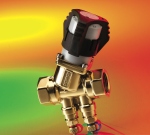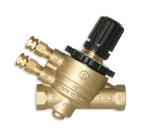Exploiting the benefits of ‘automated’ valves

‘Self-balancing valves’ and ‘automatic balancing valves’ means that there is no need for a commissioning engineer. Right? Tony Anderson, chairman of the Commissioning Specialists’ Association’s training committee believes that the commissioning engineer’s role is more important than ever.
Commissioning a system that contains ‘automated valves’ should be quick and pain free for the commissioning engineer. However this is rarely the case. Over the last 20 years ‘automated valves’ have become the front runners in the commissioning valve market. CFRs, DPCVs, PICVs and EPICV/EPIVs (see the explanation panel on this page) are a just a few types available, each having their own sophisticated characteristics that can offer huge benefits in hydraulic applications.
When installed with variable-flow pumps with a suitable variable-flow strategy, ‘automated valves’ can maximise flow efficiency, greatly reduce operational costs and offer enormous energy savings to end users, in comparison with a traditional fixed-flow system, over the operational life-span of the system.
From the off, it’s worth noting the terms ‘automated’ and ‘self-balancing’ are brochure-type slogans that largely makes reference to how the valves operate and control water flow after they have been set-up and commissioned. As a specialised component, one of the key challenges with automated valves is getting the system to a commissioned state to allow the valves to perform at the design intent.
Designers should use caution when assigning the pumping strategy around automated valves that the entire system selected is maintainable and also lends itself to be flushed sufficiently. I have witnessed on a number of projects ‘temporary’ by-pass loops being installed retrospectively around the automated valve or component, as the energy-efficient design model did not allow for suitable flushing and back-flushing of all system components. This was a lengthy and costly addition to each project. In each instance it was of no coincidence that the commissioning team was not appointed until hydraulic installations were at advanced installation level.
Specialist care is required when performing the pre-commissioning cleaning of systems that contain automated valves. It is possible that each automated valve has a specific flushing mode or dedicated flushing bypass installed; however, this is rarely found to be the case on-site. CFRs of the removable-cartridge type, for example, will have to have be bypassed or have their cartridges fully removed in order to achieve flushing velocities; the BSRIA standard flushing velocity or design +10% will not be achievable with the cartridge in place. Careful handling has to be undertaken if removing and storing these cartridges to ensure these are not damaged and that they are correctly identified and re-installed in their original location and orientation. Most types of DPCVs must also completely isolated during the initial flushing exercise.
Alterations made to the system for flushing activities need to be recorded, and the system needs to be re-instated to ‘full-flow’ condition before commissioning activities can commence. Proving the system has been reinstated and that control valves and flow cartridges are re-installed back to their original positions is a pivotal verification step on these types of systems.
The importance of pre-commissioning cleaning again highlights the benefits of engaging a specialist commissioning engineer’s perspective at the design stage as they can offer advice on the installation, chemical cleaning, commissioning and maintenance requirements of these valves and the system as a whole. Small changes, additions or alterations at design stage can make significant operational and maintenance savings in the long term.
| Automated commissioning valves explained | |
 |
CFR: constant flow regulator — a device that maintains a constant flow rate regardless of pressure fluctuations within a water distribution system. The device is either of the cartridge type or of the externally adjustable type. This externally adjustable example is from Frese. |
| DPCV: Differential-pressure control valve that can be set to a maximum differential pressure, above which it absorbs unwanted pressure to ensure that the flow does not exceed a desired value. This example is from Danfoss. |  |
 |
PICV: Pressure-independent control valves act as a differential-pressure control valve, a regulating valve and a 2-port control valve — all in one. This example is from Marflow Hydronics. |
| EPIV: Electronic pressure independent valve — a Belimo product that monitors the water flow rate through it and continually modulates to maintain the desired flow. They can communicate with a BMS via conventional or Belimo MP-Bus protocols. |  |
So what advantages do ‘automated valves’ offer to the commissioning of a system?
A traditional proportional-balancing exercise on a fixed-flow system over a large circuit could mean revisiting and adjusting individual commissioning valves two or three times. The second and third times are the fine-tuning exercise, as excess flow from around the circuit can change the flow characteristics within a leg that has already been proportionally balanced.
On an ‘automated circuit’ with automated valves on multiple branches, after a branch has been balanced there is no need for a second or third fine-tuning exercise.
On a balanced branch with an automated valve set-up, the CFR, for example, would operate by limiting the maximum flow to this branch. Alternatively, a DPCV would counteract excessive pressure fluctuations by maintaining a constant pressure in the branch, regardless of what happens in the rest of the circuit.
So the real benefit to the commissioning a system with automated valves comes after this initial balance and set-up phase as such valves can save a great deal of time by eliminating the need for fine tuning.
Adversely, the commissioning engineer has to invest time in setting up the valve up in the first instance and then perform a varying-flow proving exercise. This involves the engineer being able to demonstrate that when different parts of the hydraulic circuit have been isolated design flowrates in other parts of the circuit are maintained. This step proves that the variable-flow strategy works across the entire system.
Nowadays, buildings can contain numerous automated valves or combinations of different types of automated valves installed in various parts of the same system. The criticality for the commissioning engineer therefore shifts to understanding how the various valves are intended to interact and operate as a complete system, not simply how each valve operates individually.
The clearest path to successfully commissioning and maintaining these systems is making sure the knowledge of how each hydraulic system is intended to be chemically cleaned, operated and be maintained is shared between designer, installer, commissioning engineer and future maintenance teams.
With designers continually striving to produce the most energy-efficient solution to heating and cooling needs, the complexity of variable-flow models is forever increasing. As automated valves form an integral part of how each of these intricate design models operate, a specialist commissioning engineer should ‘automatically’ be selected at the earliest opportunity to help transform them into a fully functioning reality on-site.







